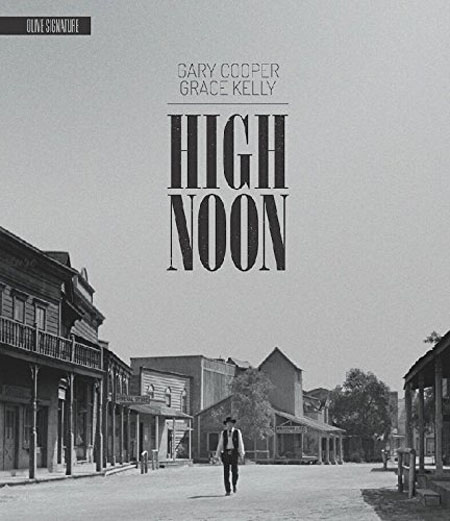
“WATCH
THE CLOCKâ€
By
Raymond Benson
Whether
he was acting as a producer or as a director, Stanley Kramer was always at the
forefront of social issues embedded within motion pictures that were ultimately
entertaining and popular. He was producer of many outstanding movies during the
early half of his career, and then went on to direct more high-profile
Hollywood “message pictures.â€
The
esteemed and beloved High Noon, an “anti-western†released in 1952, was
a production Kramer oversaw with his then associate Carl Foreman, who penned
the screenplay. In a much publicized and analyzed split, the two men “divorcedâ€
during production of the film, mainly because Foreman was called before the
House Un-American Activities Committee, admitted he had once been a member of
the Communist Party, and refused to name names. Before he could be blacklisted,
Foreman left the United States and moved to Britain. He agreed to have his name
removed from High Noon as Associate Producer; but he still received
credit for the screenplay, which may or may not have been based on a short
story called “The Tin Star,†by John W. Cunningham. (Kramer had purchased the
rights to the story because it had a similar premise, and he was likely
covering his bases.) Astonishingly, Foreman still received an Academy Award
nomination for his script, even when many of his writing colleagues in
Hollywood had to use “fronts†on their work, or they couldn’t get jobs at all.
Setting
aside all that drama, perhaps the real credit for the success of High Noon should
go to director Fred Zinnemann, who was the up and coming talent and future
two-time Oscar winner, and star Gary Cooper, who won the Oscar for Best
Actor for his performance as Will Kane, the retiring marshal of the small New
Mexico town of Hadleyville. The film also won for its dynamic and extremely
important editing (by Elmo Williams and Harry W. Gerstad) that gave audiences
the sense that they were viewing the suspenseful action in real time, and two
trophies for music—the score by Dimitri Tiomkin, and for the song by Tiomkin
and Ned Washington (“High Noon,†performed by Tex Ritter, although it is known
in popular circles as “Do Not Forsake Me, Oh My Darlin’â€). High Noon received
nominations not only for the Screenplay, but for Director Zinnemann and for
Best Picture.
Most
of you know the story. Marshal Kane (Cooper) has just gotten married to Amy
(Grace Kelly; never mind that she’s about 30 years younger than Cooper), when
he learns that bad man Frank Miller (Ian MacDonald) has been paroled and is on
his way to town to kill Kane. He will arrive on the noon train, and his three equally-bad
cohorts (Lee Van Cleef in his first screen appearance; Sheb Wooley, who years
later gave us the novelty song, “The Purple People Eaterâ€; and Robert J. Wilke)
are at the station waiting for him. Kane desperately attempts to round up
supporters to help him fight Miller and his gang, but no one in the town will step
up to support their marshal (the outstanding supporting cast includes Thomas
Mitchell, Lloyd Bridges, Lon Chaney, Katy Jurado, Otto Kruger, and Harry
Morgan). Cowards all. Even Amy leaves her new husband because he won’t run out
on his responsibility. Meanwhile, we are made aware of every clock in the town
as the ticking progresses closer to high noon. The pendulums swing, the big
hands move closer to 12, and the tension mounts. Kane is left alone to face the
killers…

Of
course, we all know now that High Noon is an allegory for the Hollywood
blacklist. It was Carl Foreman’s treatise on what was happening in Tinsel Town
at the time. The townspeople, who were the marshal’s friends, turn their backs
on him and leave him to “face the music†alone. John Wayne famously rejected
the role of Kane when it was first offered to him, and he went on the record,
along with director Howard Hawks, calling High Noon a “Commie picture.â€
Ironically, Gary Cooper was not in town when he was awarded his Oscar—and Wayne
accepted the trophy for his pal on the night of the ceremony.
Olive
Films’ spectacular Blu-ray is absolutely gorgeous in its glorious black and
white. It is a new 4K restoration that is crystal clear, giving one the
impression that the movie was made yesterday.
There
are nice supplements included. A piece on the editing of the film illustrates
how the ticking clocks are so important for the pace of the picture. Film
historian Michael Schlesinger enthusiastically presents a featurette on
producer Kramer. Blacklisted screenwriter Walter Bernstein and film historian
Larry Ceplair talk about the Hollywood blacklist and its relation to High
Noon. Anton Yelchin narrates a visual essay of rarely seen archival
elements on the production history of the film. Finally, there is an original
essay (on screen and in the enclosed booklet) by Sight & Sound editor
Nick James, along with the theatrical trailer.
High
Noon exists
on Blu-ray distributed by other companies, but the Olive Films presentation is
top-notch. A classic masterpiece is always worth an upgrade.
CLICK HERE TO ORDER FROM AMAZON